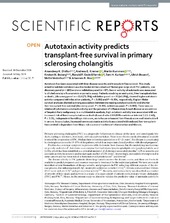Autotaxin activity predicts transplant-free survival in primary sclerosing cholangitis
Dhillon, Amandeep Kaur; Kremer, Andreas E.; Kummen, Martin; Boberg, Kirsten Muri; Elferink, Ronald P. Oude; Karlsen, Tom Hemming; Beuers, Ulrich; Vesterhus, Mette; Hov, Johannes Espolin Roksund
Peer reviewed, Journal article
Published version

Åpne
Permanent lenke
https://hdl.handle.net/1956/20800Utgivelsesdato
2019-06-11Metadata
Vis full innførselSamlinger
Originalversjon
https://doi.org/10.1038/s41598-019-44762-7Sammendrag
Autotaxin has been associated with liver disease severity and transplant-free survival. This study aimed to validate autotaxin as a biomarker in two cohorts of Norwegian large-duct PSC patients, one discovery panel (n=165) and one validation panel (n=87). Serum activity of autotaxin was measured in diluted sera by a fuorometric enzymatic assay. Patients reaching an end-point, liver transplantation or death, (discovery panel: n=118 [71.5%]; validation panel: n=35 [40.2%]), showed higher autotaxin activity compared with the other patients, P<0.001 and P=0.004, respectively. Kaplan-Meier survival analyses showed a strong association between increasing autotaxin activity and shorter liver transplant-free survival (discovery panel: P<0.001, validation panel: P=0.001). There was no relationship between autotaxin activity and the presence of infammatory bowel disease or occurrence of hepatobiliary malignancy. In a multivariable analysis, high autotaxin activity was associated with an increased risk of liver transplantation or death (hazard ratio 2.03 (95% confdence interval 1.21–3.40), P<0.01), independent from Mayo risk score, an in-house enhanced liver fbrosis score and interleukin-8 in serum. In conclusion, increased serum autotaxin activity is associated with reduced liver transplantfree survival independent from Mayo risk score and markers of infammation and fbrosis.
